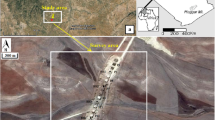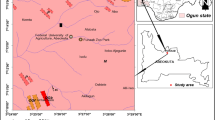Abstract
Electrical Resistivity Imaging (ERI) and Ground-Penetrating Radar (GPR) methods were utilized in this study to identify soil profiles around Necatibey Subway Station of Kızılay–Çayyolu metro line, Ankara, Turkey. The Necatibey Metro Station is located within the alluvial deposits of Dikmen stream and the so-called Ankara clay. At the metro station, a number of boreholes were drilled. However, due to the spacing of the boreholes the boundary between alluvium and Ankara clay deposits could not be separated precisely. Thus, in this study, ERI and GPR methods were utilized to distinguish soil types at the study area. GPR measurements were taken from a total of 14 profiles and total length of the profiles was about 320 m. For every ERI measurement section, Schlumberger Dipole–Dipole, Dipole–Dipole, Schlumberger and Wenner arrays were used. Results from the geophysical measurements identified that the fill materials are underlain by the Dikmen stream channel deposits, which consist of silty clay and gravelly sand units. The study also shows that the Dikmen stream channel deposits are underlain by the Ankara clay unit. The meaningful range of resistivity values was between 1 and 15 Ωm, and the GPR signals were strong in sandy units while they attenuated in clayey environments. Based on borehole logs, ERI and GPR data, three-dimensional lithological subsurface model of the survey area was constructed. The resultant three-dimensional diagrams may serve engineers as a practical tool during different construction stages, groundwater–surface water interactions within short and long term, and probable remedial measures.








Similar content being viewed by others
References
Aktürk Ö (2010) Assessment of Tunnel Induced Deformation Field Through 3-Dimensional Numerical Models (Necatibey Subway Station, Ankara, Turkey). Ph.D. Dissertation, the Graduate School of Natural and Applied Sciences of Middle East Technical University
Alshuhail AA (2006) Integration of 3D Resistivity Imaging and Ground Penetrating Radar Surveys in Characterizing Near-Surface Fluvial Environment. Master Thesis, University of Calgary, Department of Geology and Geophysics, Alberta
Annan AP (1999) Practical Processing of GPR Data. Proceeding of the Second Government Workshop on Ground Penetrating Radar, Mississauga 16 pp
Annan AP (2002) The History of Ground Penetrating Radar. Subsurf Sens Technol Appl 3(4):303–320
Annan AP (2003) Ground penetrating radar: principles, procedures and applications. Sensor and Software Inc, Mississauga, p 271
Annan AP, Cosway SW, Redman JD (1991) Water table detection with ground-penetrating radar. In: Soc Explor Geophys. Annual International Meeting Program with Abstracts, pp 494–497
Ballard RF (1983) Cavity detection and delineation research. Report 5, Electromagnetic (radar) techniques applied to cavity detection. Technical Report GL, 83–1, p 90
Barker R, Moore J (1998) The application of time-lapse electrical tomography in groundwater studies. Lead Edge 17(10):1454–1458
Beres M, Haeni FP (1991) Application of ground-penetrating-radar methods in hydrogeologic studies. Ground Water 29:375–386
Bishop I, Styles P, Emsley SJ, Ferguson NS (1997) The detection of cavities using the microgravity technique: case histories from mining and karstic environments. Geol Soc Eng Geol Spec Publ 12:153–166
Butler DK (1984) Microgravimetric and gravity gradient techniques for detection of subsurface cavities. Geophysics 49(7):1084–1096
Cagnoli B, Russell JK (2000) Imaging the subsurface stratigraphy in the Ubehe hydrovolcanic field (Death Valley, California) using ground penetrating radar. J Volcanol Geotherm Res 96:45–56
Cagnoli B, Ulrych TJ (2001a) Ground penetrating radar images of unexposed climbing dune-forms in the Ubehebe hydrovolcanic field (Death Valley, California). J Volcanol Geotherm Res 109:279–298
Cagnoli B, Ulrych TJ (2001b) Singular value decomposition and wavy reflections in ground penetrating radar images of base surge deposits. J Appl Geophys 48:175–182
Caputo R, Piscitelli S, Oliveto A, Rizzo E, Lapenna V (2003) High-resolution resistivity tomographies in active tectonic studies. Examples from the Tyrnavos Basin, Greece. J Geodyn 36:19–35
Colley GC (1963) The detection of caves by gravity measurements. Geophys Prospect XI: 1–9
Conyers LB, Goodman D (1997) Ground Penetrating Radar. Altamira Press, An Introduction for Archaeologist
Cook JC (1965) Seismic mapping of underground cavities using reflection amplitudes. Geophysics 30(4):527–538
Cristallini E, Almendinger R (2001) Pseudo 3D Modeling of Trishear Fault-Propagation Folding. J Structural Geology 23:1883–1899
Dahlin T, Zhou B (2004) A numerical comparison of 2D resistivity imaging with 10 electrode arrays. Geophys Prospect 52:379–398
Daniels DJ, Gunton DJ, Scott HF (1988) Introduction to Subsurface Radar. IEEE Proc F 135:278–320
Davis JL, Annan AP (1989) Ground Penetrating Radar for High Resolution Mapping of Soil and Rock Stratigraphy. Geophys Prospect 37:531–551
Doolitle JA, Collins ME (1995) Use of soil information to determine application of ground penetrating radar. J Appl Geophys 33:101–108
Drahor MG (2006) Integrated geophysical studies in the upper part of Sardis archaeological site, Turkey. J Appl Geophy 59:205–223
Gómez-Ortiz D, Martín-Velázquez S, Martín-Crespo T, Márquez A, Lillo J, López I, Carreño F (2006) Characterization of volcanic materials using ground penetrating radar: a case study at Teide volcano (Canary Islands, Spain). J Appl Geophys 59(1):63–78
Gómez-Ortiz D, Martín-Velázquez S, Martín-Crespo T, Márquez A, Lillo J, López I, Carreño F, Martín-González F, Herrera R, De Pablo MA (2007) Joint application of ground penetrating radar and electrical resistivity imaging to investigate volcanic materials and structures in Tenerife (Canary Islands, Spain). J Appl Geophy 62:287–300
GPRSoft (2008) Version 1.3.7. Geoscanners AB. www.geoscanners.com
Griffiths DH, Barker RD (1993) Two-dimensional Resistivity Imaging and Modeling in Areas of Complex Geology. J Appl Geophys 29:211–226
Gross R, Green AG, Horstmeyer H, Begg JH (2004) Location and geometry of the Wellington Fault (New Zealand) defined by detailed three-dimensional georadar data. J Geophys Res 109:B05401. doi:10.1029/2003JB002615
Jol HM (2009) Ground Penetrating Radar: Theory and Applications. Elsevier B.V, Amsterdam
Jol HM, Kaminsky G (2000) High Resolution 2D and 3D Ground Penetrating Radar Datasets. US Geological Survey, Open-File Report: 99–104
Jol HM, Smith DG (1991) Ground penetrating radar of northern lacustrine deltas. Can J Earth Sci 28:1939–1947
Kadioglu S, Kadioglu M, Kadioglu YK (2013) Identifying of buried archeological remains with ground penetrating radar, polarized microscope and confocal Raman spectroscopy methods in ancient city of Nysa, Aydin-Turkey. J Archeol Sci 40(10):3569–3583
Loke MH, Barker RD (1995) Least-squares deconvolution of apparent resistivity pseudosections. Geophysics 60:1682–1690
Loke MH, Barker RD (1996) Rapid least-squares inversion of apparent resistivity pseudosections by a quasi-Newton method. Geophy Prospect 44:131–152
Loke MH, Dahlin T (2002) A comparison of the Gauss–Newton and quasi-Newton methods in resistivity imaging inversion. J Appl Geophys 49:149–162
Martínez J, Benavente J, García-Aróstegui JL, Hidalgo MC, Rey J (2009) Contribution of electrical resistivity tomography to the study of detrital aquifers affected by seawater intrusion–extrusion effects: the river Vélez delta (Vélez-Málaga, southern Spain). Eng Geol 108:161–168
Martínez J, Rey J, Hidalgo C, Benavente J (2012) Characterizing abandoned mining dams by geophysical (ERI) and geochemical methods: the Linares–La Carolina District (southern Spain). Water Air Soil Pollut 223:2955–2968
McMechan G, Gaynor G, Szerbiak R (1997) Use of ground penetrating radar for 3D sedimentological characterization of clastic reservoir analogs. Geophysics 62:786–796
Menezes Travassos J, Luiz Menezes P (2004) GPR exploration for groundwater in a crystalline rock terrain. J Appl Geophys 55:239–248
Miyamoto H, Haruyama J, Rokugawa S, Onishi K, Toshioka T, Koshinuma J (2003) Acquisition of ground penetrating radar data to detect lava tubes: preliminary results on the Komoriana cave at Ruji volcano in Japan. Bull Eng Geol Environ 62:281–288
Nouioua I, Rouabhia A, Fehdi C, Boukelloul ML, Gadri L, Chabou D, Mouici R (2013) The application of GPR and electrical resistivity tomography as useful tools in detection of sinkholes in the Cheria Basin (northeast of Algeria). Environ Earth Sci 68:1661–1672
Olhoeft GR, Powers MH and Capron DE (1994) Buried object detection with ground penetrating radar. In: Proceeding of Unexploded Ordnance Detection and Range Remediation Conference, 207–233
Overgaard T, Jakobsen PR (2001) Mapping of glaciotectonic deformation in an ice marginal environment with ground penetrating radar. J Appl Geophys 47:191–197
Pratt BR, Miall AD (1993) Anatomy of a bioclastic grainstone megashoal (Middle Silurian, southern Ontario) revealed by ground-penetrating radar. Geology 21:223–226
Rashed M, Kawamura D, Nemoto H, Miyata T, Nakagawa K (2003) Ground penetrating radar investigations across the Uemachi fault, Osaka, Japan. J Appl Geophys 53:63–75
RES2DINV (2004) Version 3.54. Rapid 2D Resistivity and IP inversion using the Least Square Method. Geotomo Software, www.geoelectrical.com
Rey J, Martínez J, Hidalgo MC (2013) Investigating fluvial features with electrical resistivity imaging and ground-penetrating radar: the Guadalquivir River terrace (Jaen, Southern Spain). Sediment Geol 295:27–37
Reynolds JM (1997) An introduction to applied and environmental geophysics. Wiley, Chichester
Reynolds JM (2000) An Introduction to Applied and Environmental Geophysics. Wiley, NewYork
RockWorks (2009) Version 2009.2.5. RockWare Incorporated. www.rockware.com
Russell JK, Stasiuk MV (1997) Characterization of volcanic deposits with ground-penetrating radar. Bull Volcanol 58:515–527
Rust AC, Russell JK (2000) Detection of welding in pyroclastic flows with ground penetrating radar: insights from field and forward modelling data. J Volcanol Geotherm Res 95:23–34
Rybakov M, Goldshmidt V, Fleischer L, Rotstein Y (2001) Cave detection and 4-D monitoring: a microgravity case history near the Dead Sea. Lead Edge (Soc Explor Geophys) 20(8):896–900
Sasaki Y (1992) Resolution of resistivity tomography inferred from numerical simulation. Geophys Prospect 40:453–464
Sasaki Y, Matsuo K (1993) Surface-to-tunnel resistivity tomography at the Kamaishi Mine. Butsuri-Tansa 46:128–133
Sheriff RE (1999) Encyclopedic Dictionary of Exploration Geophysics, Society of Exploration Geophysics. 3rd edn
Slater L, Niemi TM (2003) Ground-penetrating radar investigation of active faults along the Dead Sea Transform and implications for seismic hazards within the city of Aqaba, Jordan. Tectonophysics 368:33–50
Spies B, Ellis R (1995) Cross-borehole resistivity tomography of a pilot sale, in situ vitrification test. Geophysics 60:886–898
Suzuki K, Toda S, Kusunoki K, Fujimitsu Y, Mogi T, Jomori A (2000) Case studies of electrical and electromagnetic methods applied to mapping active faults beneath the thick quaternary. Eng Geol 56:29–45
Telford WM, Geldart LP, Sheriff RE (1990) Applied Geophysics, 2nd edn. Cambridge University Press, Cambridge
TOKER Drilling and Construction Co., (2003) Ankara Rail Transit System Kızılay Söğütözü Line Construction Works, Soil Investigations Factual Report
Van Schoor M, Duvenhage D (2000) Comparison of crosshole radio imaging and electrical resistivity tomography for mapping out disseminated sulphide mineralisation at a surface test site in Mpumalanga, South Africa. Explor Geophys 30:3–4
Yalçıner CÇ, Altunel E, Bano M, Meghraoui M, Karabacak V, Akyüz HS (2013) Application of GPR to normal faults in the Büyük Menderes Graben, western Turkey. J Geodyn 65:218–227
Young R, Zhenghan D, Sun J (1995) Interactive Processing of GPR Data. Lead Edge 14:175–280
Zhou B, Dahlin T (2003) Properties and effects of measurement errors on 2D resistivity imaging. Near Surf Geophys 1:105–117
Zhou W, Beck BF, Adams AL (2002) Effective electrode array in mapping karst hazards in electrical resistivity tomography. Environ Geol 42:922–928
Acknowledgments
This paper is dedicated to the great memory of the second author Prof. Dr. Vedat Doyuran who passed away unexpectedly just after the original manuscript was sent for review. Authors are grateful to Dr. A. Arda Özacar and Mr. Ertuğ Çelik for their contributions during fieldworks. Thanks are also due to Dr. Çağıl Kolat for her help to reinterpret boring logs. Authors are also indebted to the anonymous reviewers for their constructive comments. Funding for this project was provided by Scientific Research Development Program at Middle East Technical University and Akdeniz University, and these supports are gratefully acknowledged.
Author information
Authors and Affiliations
Corresponding author
Rights and permissions
About this article
Cite this article
Aktürk, Ö., Doyuran, V. Integration of electrical resistivity imaging (ERI) and ground-penetrating radar (GPR) methods to identify soil profile around Necatibey Subway Station, Ankara, Turkey. Environ Earth Sci 74, 2197–2208 (2015). https://doi.org/10.1007/s12665-015-4211-3
Received:
Accepted:
Published:
Issue Date:
DOI: https://doi.org/10.1007/s12665-015-4211-3




